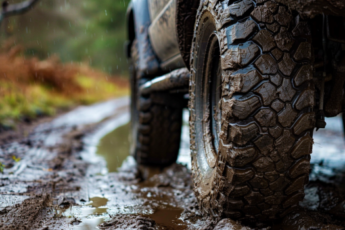Last Updated on 1 week
Expert Tips for Mastering Car Control in Winter Conditions
Winter weather conditions can pose significant challenges to drivers. Snow and ice reduce visibility and make roads slippery and difficult to navigate. With almost half a million crashes and over 2,000 fatalities occurring during winter months, according to the AAA Foundation for Traffic Safety, drivers must know how to manage snowy and icy road conditions. This comprehensive guide covers essential winter driving safety tips, from preparing your vehicle and understanding its capabilities to mastering safe driving techniques and knowing when to stay home. Let’s gear up and make your winter driving experience safer and more enjoyable.
Key Takeaways
- Stock your car with essential winter emergency supplies, such as warm clothing, blankets, food, water, and a flashlight.
- Maintain at least half a gas tank and ensure your tires have proper inflation and tread.
- Learn to control your car on slippery surfaces by driving smoothly and avoiding sudden movements.
- Stay informed about weather and road conditions, and know when to delay travel for safety.
- Regularly inspect your vehicle and select suitable winter tires to optimize snow and ice driving conditions.
- Understand how to utilize your car’s safety features, such as antilock brake systems and traction control.
- Maintain visibility by checking your vehicle’s lights, wipers, and defrosters regularly.
The Importance of Preparation for Winter Driving Safety
Proper preparation for winter driving can help ensure your safety and the safety of others on the road. By stocking your car with essentials, keeping your fuel tank full, and maintaining appropriate tire pressure and tread, you can better handle the challenges that snow and ice present.
Essentials for Your Winter Emergency Kit
A well-stocked emergency kit in your car is crucial for handling cold weather and possible delays or emergencies during winter driving. Essential items include:
- Additional food and water
- Warm clothing and blankets
- A flashlight and extra batteries
- A glass scraper and brush
- Necessary medications
- A first-aid kit
Why Keeping Your Fuel Tank Full Matters
Maintaining at least a half tank of gas during winter is imperative, as it reduces the likelihood of fuel line freeze-ups and ensures that you have enough fuel to keep warm during unexpected delays caused by winter conditions. A full fuel tank adds weight to your vehicle, providing better traction and stability on slippery roads.
Understanding the Role of Tire Pressure and Tread in Winter
Tire condition significantly impacts winter driving safety. Properly inflated tires ensure better vehicle handling, while sufficient tread provides necessary traction on snow and ice. To determine the correct tire pressure for your vehicle, consult the manufacturer’s specifications or the sticker on the driver’s side door jamb. Considering winter tires with deeper treads explicitly designed for snow and ice is a wise investment in your safety and vehicle performance.
Pro tip: Regularly check your tire pressure throughout the season, as air contracts in colder temperatures, leading to lower tire pressure.
“Remember that there is no one-size-fits-all approach to winter driving safety. Always consider your specific vehicle and road conditions when deciding on proper tire pressure and tread depth.”
Mastering Safe Driving Techniques in Snow and Ice
Driving on snow and ice can be challenging, even for experienced drivers. Acquiring safe driving techniques is essential for maintaining control of your vehicle and ensuring your safety on winter roads. This section will discuss two critical aspects of safe winter driving: smooth steering, braking, and maintaining control on slippery hills.
The Art of Smooth Steering and Braking
Driving smoothly on snow and ice requires deliberate and gradual steering, acceleration, and braking. These techniques help maintain tire traction and control, decreasing the likelihood of skidding or losing control of your vehicle. To accomplish this, follow these tips:
- Avoid abrupt or jerky movements of the steering wheel or pedals, as sudden maneuvers can cause a loss of tire traction, resulting in skidding.
- Gradually accelerate, especially on slippery surfaces, allowing the tires to maintain grip with the road.
- Adjust your speed according to the road conditions, giving yourself more time to react to obstacles and reducing the risk of losing control.
Remember, driving smoothly on snow and ice is all about being deliberate and gentle with your steering, acceleration, and braking, ensuring your tires maintain traction and control.
Maintaining Control on Slippery Hills
Slippery hills pose a unique challenge in winter driving. When ascending, maintaining momentum is essential to prevent losing traction and stalling. When descending, reducing your speed can help maintain control and minimize the risk of skidding. Here are some tips for tackling slippery hills:
- Before approaching an uphill section, gain momentum on a flat surface to avoid the need for sudden acceleration on the slope.
- Ease off the gas as you reach the top of the hill, and avoid stopping while ascending, which may cause your vehicle to slide backward.
- When descending, proceed slowly and maintain a safe distance from any vehicles before you. This will allow time to react if another car loses control or road conditions suddenly deteriorate.
By mastering these safe driving techniques, you will significantly enhance your ability to navigate snowy and icy roads, ensuring a safer driving experience for you and everyone else on the road.
Navigating Snowy Roads: Practical Tips for Everyday Commutes
For many, winter weather doesn’t eliminate the need for daily commutes. As a result, knowing when to stay home and venture out can help maintain safety and productivity levels. Daily travel can be efficient and safe by visiting informed and using caution when driving in challenging conditions.
When to Stay Home and When to Brave the Weather
Before embarking on any snowy journey, assess the necessity of the trip. Keeping informed about weather forecasts and relying on official resources, like the Department of Transportation, to make informed decisions can help you avoid unnecessary risks.
Ask yourself: “Is this trip essential? Can it be postponed or done remotely? Am I prepared to handle the road conditions?”.
If your travel is essential, it’s crucial to drive cautiously. Adjust your driving speed to accommodate decreased traction and increased stopping distances in snowy and icy conditions. Remember, it’s always better to arrive late than not at all due to an accident.
Consider the following tips to enhance safety during your winter commutes:
- Drive at a reduced speed, keeping a safe distance from other vehicles.
- Stay in your lane, avoiding abrupt maneuvers like sudden lane changes or sharp turns.
- Keep headlights on, even during daylight hours, to increase visibility.
- Be extra cautious around intersections, pedestrian crossing points, and bus stops, as these areas can be hazardous.
Ultimately, your safety and those around you should be your top priority. By understanding the risks associated with winter driving and staying informed about road conditions, you can make better decisions about when to venture out and stay home.
Long-Distance Winter Journeys: Staying Safe and Alert
Embarking on long-distance journeys during the winter months requires extra caution and preparation. Planning, staying informed, and having a well-maintained vehicle are essential for safe travels in snowy and icy conditions.
How to Check the Weather and Plan Your Route
Before setting off on a long-distance winter trip, it’s crucial to check weather conditions along your route. Utilize reliable weather websites and apps such as the National Weather Service or The Weather Channel to stay updated on the latest forecasts and any potential storms. In addition to monitoring weather conditions, planning your route ahead of time sets the foundation for a safe journey. Research alternative routes in case of road closures or hazardous conditions and choose well-traveled, well-maintained roads whenever possible.
Preparation also involves notifying family members or friends about your travel itinerary, including your planned route and estimated arrival time. In unexpected events, having someone informed about your whereabouts can be extremely helpful.
Delay trips if severe weather is expected and stay connected and informed throughout your journey.
While traveling, stay informed about any changes in weather conditions or potential road hazards. Maintain a fully charged cellphone and use weather and traffic apps to receive real-time updates. Consider bringing a portable car charger to power your devices throughout your journey.
- Check the weather forecast.
- Plan your route and alternatives.
- Notify someone of your itinerary.
- Stay informed and connected during your trip.
Regardless of the weather, always be prepared for unexpected circumstances. Equip your vehicle with an emergency kit containing blankets, warm clothing, non-perishable food, and water. Regularly inspect your vehicle to ensure it’s in peak condition and ready for long-distance winter driving.
| Before Your Trip | During Your Trip |
|---|---|
| Check the weather forecast | Stay informed about weather changes |
| Plan your route and alternatives | Use traffic and weather apps for real-time updates |
| Notify someone of your itinerary | Maintain a charged cellphone |
| Prepare a well-maintained vehicle | Equip your car with an emergency kit |
Taking the necessary precautions and staying informed throughout your long-distance winter journey ensures your safety and the safety of others on the road. By following these guidelines, you can confidently navigate the challenges of snowy and icy conditions.
What to Do If You’re Stranded in Snow
Getting stranded in snow can be a frightening experience. It’s essential to remain calm and act wisely to ensure your safety. Here are some crucial steps to follow if you are stranded in your vehicle during a snowstorm.
- Stay with your vehicle: Your car is your best shelter during a snowstorm. Do not attempt to walk in the storm, as you may lose your way and become more vulnerable to the extreme weather conditions.
- Conserve your energy: It’s essential to avoid overexerting yourself while trying to dig out your vehicle or push it. Excessive physical activity can lead to exhaustion and an increased risk of hypothermia.
- Signal for help: Tie a brightly colored cloth or a distress flag to your vehicle’s antenna or window to alert rescuers of your location.
- Ensure exhaust pipe is clear: Check your vehicle’s exhaust pipe periodically to ensure it’s free of snow and debris. A blocked exhaust pipe can result in deadly carbon monoxide accumulation inside the car.
- Run the engine and heater judiciously: Conserve fuel by running your engine and heater periodically, just enough to keep you warm and reduce the chill.
“Your car serves as your best shelter during snowstorm. Do not attempt to walk in the storm, as you may lose your way and become more vulnerable to the extreme weather conditions.”
Recognizing the differences between a typical snowstorm and an actual blizzard can help you determine the seriousness of your situation:
| Snowstorm | Blizzard |
|---|---|
| Snowfall with wind speeds up to 30 mph | Heavy snowfall with wind speeds exceeding 35 mph |
| Visibility reduced to 0.5 miles or less | Visibility reduced to 0.25 miles or less |
| Gradients or drifting snow | Significant drifting and high snow accumulation |
| Duration of 3-6 hours | Period of at least 3 hours |
While following these steps can significantly improve your chances of surviving a snowstorm, remember that proper preparation and sound judgment are paramount. Ensure you keep an ample supply of essentials in your vehicle, maintain a full gas tank, and regularly check weather forecasts to avoid getting stranded in adverse weather conditions.
Keeping Your Car in Peak Winter Condition
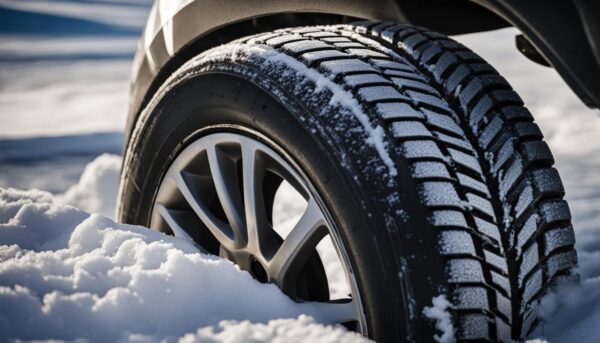
Ensuring your car’s optimal performance during the winter months is crucial for your safety and that of other road users. Regular vehicle checks and appropriate winter tires prepare your car for snow and ice.
The Necessity of Regular Vehicle Checks
Winter weather can take a toll on your car, causing problems with battery performance, cooling systems, and overall vehicle readiness for unfavorable conditions. Regular vehicle inspections, particularly before long trips, can help identify and address potential issues early.
Some key components to check before hitting the road during winter include:
- Battery: Ensure it is fully charged and in good condition
- Cooling system: Check antifreeze levels and verify that the system is working correctly
- Heaters and defrosters: Confirm they are functioning properly to keep your car’s interior warm and windows clear
- Lights: Verify all vehicle lights and signals are working correctly
- Brakes: Inspect for wear and replace if necessary
Choosing the Right Winter Tires for Snow and Ice
Winter tires are designed for snow and ice driving, improving traction, handling, and safety. The correct set of tires can significantly enhance your car’s performance under wintry conditions.
Selection Factors for Winter Tires:
- Treadwear: Look for tires with low wear rates, as indicated by higher treadwear numbers in the Uniform Tire Quality Grading System (UTQGS)
- Traction performance: Tires should have an exceptional grip on slippery surfaces. UTQGS traction ratings range from AA (best) to C (worst)
- Temperature resistance: Choose tires with low rolling resistance and high-temperature resistance, as indicated by an ‘A’ or ‘B’ UTQGS temperature rating
- Vehicle manufacturer’s recommendations: Verify the recommended tire size, type, and performance specifications for your vehicle to ensure proper fitment and function
Investing in high-quality winter tires designed for snow and ice conditions increases your safety and enhances your driving experience during the colder months.
By performing regular vehicle checks and choosing the right winter tires, you can keep your car in peak condition, navigate snow and ice safely, and have a more enjoyable driving experience throughout the winter season.
Understanding and Utilizing Your Car’s Safety Features
One of the essential aspects of safely driving in winter conditions is being familiar with your vehicle’s safety features. This enhances your control over the car on snow and ice and helps you get the most out of the driver assistance technologies during harsh winter months. Let’s delve into the critical components, such as the antilock brake system (ABS) and traction control, to help you better navigate slippery roads.
ABS is designed to prevent the wheels from locking up during emergency braking situations, which helps maintain steering control. This is particularly useful when trying to stop on slippery surfaces. To effectively use ABS, you need to apply firm, continuous pressure on the brake pedal and let the system modulate the braking pressure, keeping your eyes on the road and steering in the direction you intend.
Traction Control
Traction control is a standard feature on most modern vehicles, and it helps to maximize grip by preventing wheel spin. This is essential in limiting the loss of control on slippery surfaces like snow or ice. As traction control works automatically, you need to be aware of its presence and understand how it aids in maintaining control.
Driver Assistance Technologies
Modern cars are equipped with various advanced driver assistance systems (ADAS), which can improve your safety during winter driving. Some common feature examples are:
- Adaptive Cruise Control (ACC)
- Lane Keep Assist (LKA)
- Blind Spot Monitoring (BSM)
- Around View Monitor (AVM) or 360-degree Camera
- Automatic Emergency Braking (AEB)
Always consult your vehicle’s manual to learn about the specific features offered and how they can be utilized effectively during winter driving. Remember, these technologies are meant to assist you, but you should still be fully engaged and attentive while behind the wheel.
“Familiarity with your vehicle’s safety features is crucial for maximizing control and getting the most out of driver assistance technologies during harsh winter months.”
In conclusion, understanding and utilizing your car’s safety features can significantly enhance your winter driving experience. As a responsible driver, take the time to familiarize yourself with these systems and learn how to use them effectively, helping you maintain control during slippery and unpredictable winter conditions.
Dealing with Winter Visibility: Lights, Wipers, and Defrosters
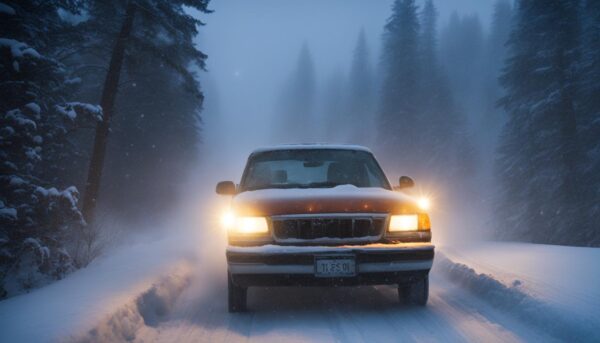
Winter driving challenges include reduced visibility due to snow, ice, and fog, so maintaining proper lighting, windshield wipers, and defrosters is crucial. These elements play a significant role in keeping you and other road users safe.
Vehicle Lights: Headlights, Tail Lights, and Signals
Ensure all vehicle lights, including headlights, tail lights, and turn signals, function correctly and are free of snow and ice. Clean and replace burnt-out bulbs to improve visibility, allowing you to see and be seen by others on the road.
Consider upgrading to high-performance halogen bulbs or LED lights for better illumination. Always use your low beams during snowfall to prevent glare from the snow and ice.
Windshield Wipers: Quality Fluid and Blade Inspections
Using high-quality winter fluid in your windshield wiper system helps clear ice and snow from the windshield. This specialized fluid is designed to withstand colder temperatures and prevent freezing.
Regularly inspect and replace wiper blades as needed. Worn-out or damaged wiper blades hamper visibility and are less effective in clearing snow and ice. Winter wiper blades, equipped with a rubber covering to prevent ice buildup, improve performance in harsh conditions.
Pro Tip: Keep an extra set of wiper blades in your vehicle as a backup during winter months.
Defrosters: Clearing Windshields and Windows
Check your vehicle’s front and rear defrosters to ensure they function effectively. These systems prevent ice buildup and remove condensation, allowing for maximum visibility in winter conditions.
- Turn on the defrosters before driving, allowing ample time for windows to clear.
- Regularly inspect defroster vents and heating systems for damage or blockages.
- Equip your vehicle with an ice scraper and snow brush to assist in clearing windows, mirrors, and lights as needed.
Maintaining winter visibility through functional lights, wipers, and defrosters is essential for safe driving in snow and ice. These precautions allow you to enjoy a safer and more confident winter driving experience.
Conclusion
Adapting to winter road conditions is crucial for ensuring the safety of all motorists. You can confidently navigate snowy and icy roads by taking the necessary precautions, understanding your vehicle’s capabilities, and following safe driving practices. Proper preparation and vigilance are essential for minimizing risks and protecting yourself and others on the road.
Adapting to Winter Road Conditions with Confidence
Stay informed about weather and road conditions, as this information is vital for making decisions about your travel plans. Knowing when to delay travel for safety reasons is crucial for avoiding unnecessary risks and protecting yourself and your passengers. When on the road, remain alert and adapt your driving habits to the changing circumstances.
Essential Takeaways for Winter Road Safety
To ensure a safer winter driving experience, remember these fundamental principles: prepare your vehicle for winter, know how to control your car on snow and ice, and understand the importance of staying up-to-date with weather and road conditions. Carry adequate supplies, conduct regular vehicle checks, and consider the weather forecast when planning your journey. By assessing your safety and the well-being of others on the road, you’ll be better equipped to handle the challenges of winter driving.
Explore a vast selection of top-quality tires at Giga Tires, where affordability meets reliability. Find the perfect fit for your vehicle with our easy-to-use search tools and benefit from competitive pricing and exceptional customer service. Choose Giga Tires for a hassle-free tire buying experience.”
FAQ
What essentials should be included in a winter emergency kit?
Your winter emergency kit should include additional food and water, warm clothing, blankets, a flashlight, a glass scraper, necessary medications, and other items to help you handle cold weather and possible delays or emergencies.
Why is keeping your fuel tank full vital during winter?
Maintaining at least a half tank of gas during winter reduces the likelihood of fuel line freeze-ups and ensures you have enough fuel to keep warm during unexpected delays caused by winter conditions.
How do tire pressure and tread impact winter driving safety?
Proper inflation ensures better vehicle handling, while sufficient tire tread provides necessary traction. Always check the manufacturer’s specifications for correct tire pressure and consider winter tires with a more profound impression of driving in snow and ice.
What are some safe driving techniques for snow and ice?
Drive smoothly on snowy and icy roads with deliberate and gradual steering, acceleration, and braking. This helps maintain tire traction and control. Avoid jerky movements to prevent skidding, and adjust your speed according to road conditions.
How can I maintain control on slippery hills?
Gain momentum on flat surfaces before uphill sections and ease off the gas as you reach the top. Avoid stopping while ascending and proceed downhill at a reduced speed to maintain control on slippery inclines.
When should I stay home instead of driving in winter weather?
Assess the necessity of your trip during bad weather conditions. Staying home is advisable to avoid risks; however, if travel is essential, drive cautiously, accommodating decreased traction and increased stopping distances.
How can I stay safe during long-distance winter journeys?
Prepare your vehicle for travel, check weather conditions along your route, and notify others of your itinerary. Delay trips if severe weather is expected, and stay connected and informed throughout your journey.
What should I do if I’m stranded in the snow?
If stranded, remain with your vehicle for shelter. Signal distress with a brightly colored cloth and clear exhaust pipe to avoid carbon monoxide poisoning. Conserve fuel by running the engine just enough to reduce the chill.
How can I keep my car in peak winter condition?
Conduct regular vehicle inspections to identify potential issues, including battery performance, cooling system adequacy, and overall vehicle readiness for winter conditions. Choose suitable winter tires for driving in snow and ice.
How can I maximize the use of my car’s safety features during winter?
Familiarize yourself with your vehicle’s safety features, such as antilock brake systems (ABS) and traction control. Learn how to properly employ these features and other driver assistance technologies under wintry conditions to enhance safety.
How can I improve visibility during winter driving?
Maintain visibility by ensuring all vehicle lights and signals are functioning correctly. Use high-quality winter fluid in windshield wipers, regularly inspect and replace wiper blades as needed, and check that your vehicle’s defrosters are working effectively to prevent ice buildup.




